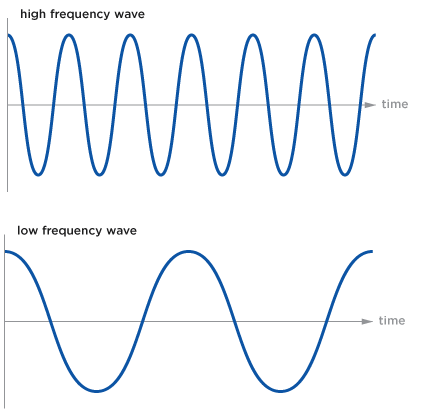Ok, not like that, necessarily... More like this:
Ok, one more time let's try it one more time....

Got it! Finally right? So what are waves? Waves are anything that transfers energy from one place to another.And there are two types: mechanical and electromagnetic. Let's talk about mechanical first.
Mechanical waves need a medium to go through. Sound and seismic waves are mechanical waves because they need to move through something. All this talk about mediums, I bet you're wondering where large and small are right? Well obviously you have no idea what type of medium I'm talking about. This type of medium is a kind of matter disturbed by energy. So water waves move through the medium that is water molecules. I guess you can say that information made a....

Splash! Sorry, I had to. God I'm horrible. Now for an electromagnetic waves! Electromagnetic waves are waves that are produced by the acceleration of an electric charge. At least that's what this website says. These waves don't need a medium to go through. See the difference?
Ok so now I have to show you something else. Don't worry, it's easy. Kinda.
Next we are going to talk about transverse and compressional/longitudinal waves.

Wee! Ok enough joking around. I'm saying ok a lot... Moving on. Transverse waves carry energy (like all waves do) at a right angle towards energy. Therefore they travel in that ^^^^ pattern. Compressional or longitudinal waves are shock waves that compresses the medium which it is transmitted through. Again, at least that's what this website says.
So the next few, since I'm lazy, I'm just going to put in bullets.
- The top of a wave is called the crest
- The bottom of a wave is called the trough
- The middle of a wave to the crest is called the amplitude
- Wavelength is how you measure the amount of energy or the size of the wave is measured from crest to crest, or trough to trough.
- Then there's frequency. If you have a high frequency, then you have a high wave with short wavelengths. If you have a low frequency, then you have a low wave with long wavelengths.
I hope that made sense.
Visual time!
So I'm about to show you something awesome.

Well the gif does two things. 1) It kinda gives you a glimpse into the fun fact I'm about to share and 2) It kinda reminds me of a friend when she gets angry. She knows who she is.
Fun fact about vibration: Vibration makes sound because the sound is vibration! Ok let me explain before you go all, "What the heck is wrong with her?" A lot actually, but that's beside the point. Sound is caused by the vibration of tiny particles. So yeah, vibration is sound.
So I hope I helped! I've been sick for the past few days and I still kinda feel like crap. Sorry if this post wasn't as good. Any who all of my information came from here! As per usual the pictures are just a CTRL +Click away! See ya next time! Byeeeeee xx-G



